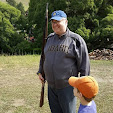This past Saturday my wife worked while I stayed home with the boy. While Jack has given up his afternoon nap, I'm still able to get some hobby work done while he plays.
Our house has a pretty open floor plan, with kitchen, dining room, and breakfast nook all in one big area. We put up a baby gate to block this area from the rest of the house, and we keep all Jack's toys in there. He can play while I work on the island and watch him. Saturday I based up all 160 Confederate infantry while Jack prepared food in his toy kitchen.

Materials
I cleaned the edges of 40 Litko bases with a paper towel and a little warm water. I had been storing the painted figures 10 to a popsicle stick.
I broke the figures off their storage sticks and arranged them for basing. I had 32 poses, which made for eight different groups of four poses each. Each group would make for five bases. I tried to vary hat styles, blanket rolls v. backpacks, and uniforms' color schemes on each base.
I put out five bases for each group, then put four Elmer's Glue All beads on each base. I worked in groups of ten bases to keep the glue from getting too tacky.
It took about 20 minutes to get to this point. Then I had to walk away for a couple of hours to let the glue set.
After the glue was fairly dry, I painted the base edges with brown iron oxide paint. I know a lot of people like to leave their Litko base edges alone, but I think they look better painted.
I painted each base in spice brown, then gave it a swirl through the medium brown ballast while the paint was still wet. This is the most time consuming step of all, taking about a half hour to complete.
Once the paint is dry, I gave each base an Elmer's glue wash. This keeps the ballast from scattering each time the stand is handled. It also gives me a firmer surface on which to apply a light chocolate drybrush, highlighting the base and giving it a nice dirt effect.
The last step is to apply static grass. I use slightly diluted Elmer's glue, hitting various spots around the base. Then I swirl the base through my static grass bowl, tap off the excess, blow off any remains, and set the figures aside to dry.
All told, I spent about two hours on Saturday basing 160 figures. Economy of scale, gentlemen. It's the only way to finish large armies quickly.


















Thanks for the step by step- I was shocked at the speed you were able to complete them. My basing always seems to take forever because the sand/gravel seems to soak up the paint and need at least a 2nd touch up before I can even drybrush.
ReplyDeleteExcellent instruction! You are truly an inspiration. I only wish you lived in Oz, I'd be broke and you would be rolling in commissions!
ReplyDeleteI'm thick, but what do you mean by "economy of scale"?
Keep up the fantastic work!
Regards
Ian ("Bucko")
Economy of scale = savings realized by working in large numbers. It's how Walmart and McDonald's make all their money. They can keep things cheap by working with huge quantities.
ReplyDeleteIn my case, I save a ton of time by working with large numbers of figures at a time. Instead of spending an hour and a half basing 20 men, I spend two hours basing 160 men. I can do that because the setup and take down time remain the same for a small or a large project, and the more I do a repetitive action (like painting the sides of bases, or applying a glue wash), the faster I get.